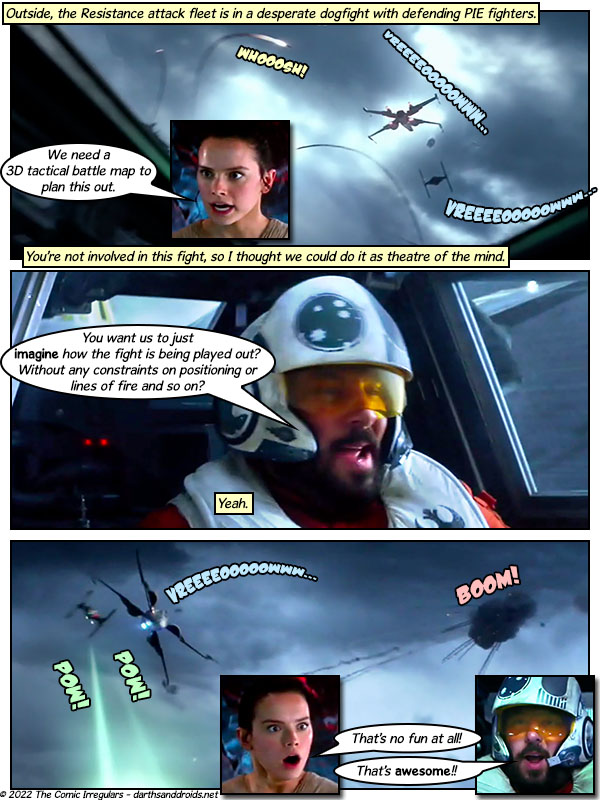Theatre of the mind is a playing style (for roleplaying games) in which the players imagine what scenes look like without assistance from props or other game aids, usually specifically combat maps and miniature figures. The term is most often used as a descriptor for combat, to contrast with the use of a physical map and miniatures to keep track of the positions of combatants and significant terrain features.
There are more and less complete versions of theatre of the mind. A fully theatre-of-the-mind game would use no props at all, meaning no large scale maps, diagrams, illustrations, or props such as player handouts replicating in-game items such as letters. This is quite extreme, as many games will use at least some of these items, even if they never use detailed combat maps or miniatures.
More common is to use theatre of the mind for combat, but allow props such as large scale maps showing continents, countries, cities, etc. When combat occurs, the Game Master will simply describe the location in words, give a verbal rundown of the antagonists, and then let players select their actions. A player may say they want their character to fire arrows, or cast spells, or close for melee combat, or seek cover or whatever other action, and the GM judges if they can attempt it or not given their internal imagined battle scene. This version of combat can be very fluid, with unexpected and cinematic actions taking place at the GM's discretion.
The contrasting option is to use a battle map, often covered with grid squares or hexagons for moderating movement, and showing the precise location of walls, furniture, and other terrain features. Miniature figures representing each character and enemy are placed in the map, so all can see their precise locations and lines of sight to other combatants. The map then decides if combatants are within range for various actions and how far they can move. This version of combat is more tactical, relying on specific use of movement and range values for various combat actions.
Neither combat style is inherently superior to the other - it depends on how you like to play and each has plenty of fans. In the early days of its history, Dungeons & Dragons was very much theatre of the mind, with combat maps and miniature figures considered very much optional. (I personally never played with them for many years.) Through its edition revisions, D&D has become more tactical and it's now considered more normal for combat to be conducted with a battle map and miniatures, although there are still plenty of people who prefer theatre of the mind.
Commentary by memnarch (who has not seen the movie)
Those faces are perfect for how Pete and Sally are reacting.
Both methods have their advantages of course. 3D maps allow for providing all the details to the players so they can make informed decisions without being concerned if they're missing something, like another player's actions. Theatre of the mind, on the other hand, gives players flexibility to do unusual moves that would have been highly unlikely otherwise, like suddenly flying or just climbing around on the ceiling when everything else has been acting in a 2D plane.
Personally, I think the better method depends on the game system being used and which method it's designed to use. Dungeons & Dragons for example, could work with TotM, but it wouldn't excel at it given all the references to positioning, flanking, sizes, etc. Fellowship however, (or another Powered by the Apocalypse type), would be hard pressed to have a grid in the first place as there tends to be no generic attack skills or moves to build a grid around.
This system that the characters are using? With how many supplement books and extra rules there are (a whole extra book just for grappling!), I wouldn't be surprised if there's yet another book on how to adapt things to be run in TotM instead.
Transcript
GM: Outside, the Resistance attack fleet is in a desperate dogfight with defending PIE fighters.
[SFX]: whooosh!
[SFX]: vreeeeooooowww...
[SFX]: vreeeeooooowww...
Rey: We need a 3D tactical battle map to plan this out.
GM: You’re not involved in this fight, so I thought we could do it as theatre of the mind.
Snap Wexley: You want us to just imagine how the fight is being played out? Without any constraints on positioning or lines of fire and so on?
GM: Yeah.
[SFX]: vreeeeooooowww...
[SFX]: Pow!
[SFX]: Pow!
[SFX]: Boom!
Rey: That’s no fun at all!
Snap Wexley: That’s awesome!!

